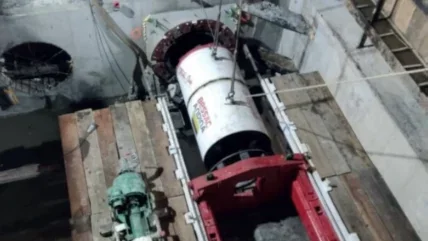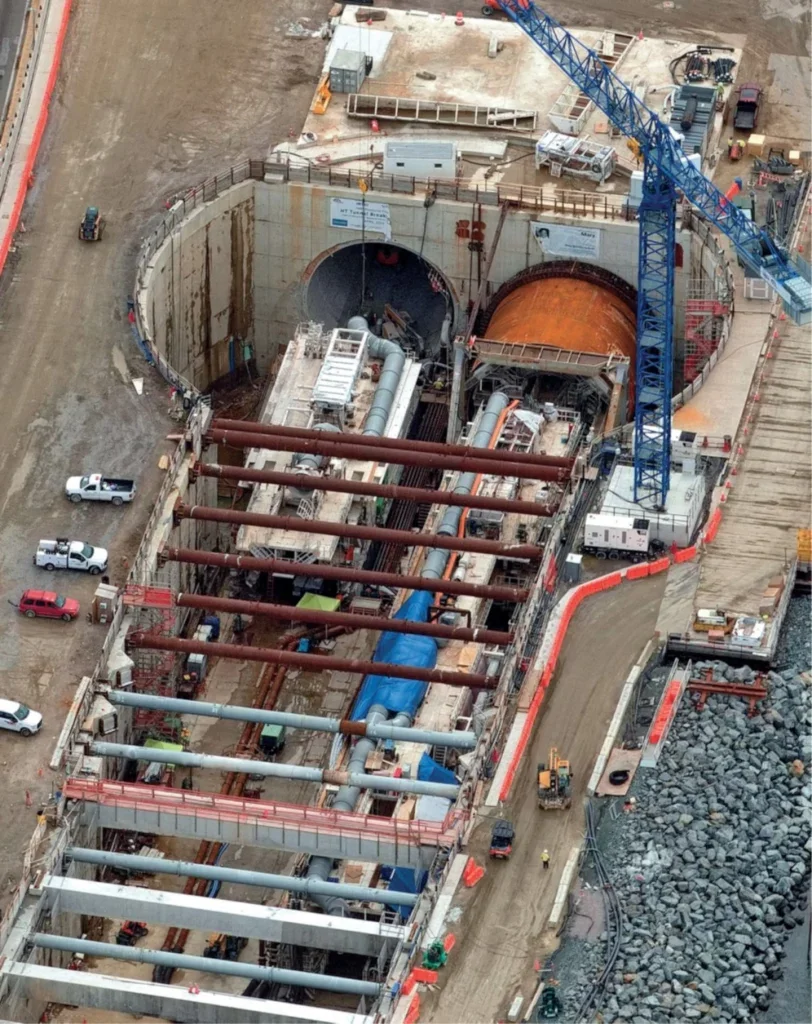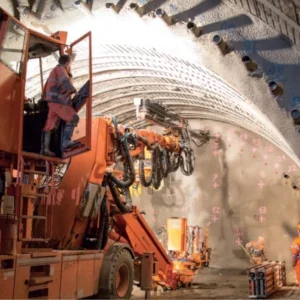
TBM LAUNCHED ON SECOND SUBSEA BORE FOR HRBT
Tunneling is under way on the second bore of the Hampton Road-Bridge Tunnel Expansion project (HRBT) in Virginia.
TBM ‘Mary’ is making the return journey back towards South Island after breaking through at the North Island reception pit, early last year, to complete the first subsea bore. The project is Virginia’s first bored road tunnel.
Following the first drive, the variable density TBM was rotated on nitrogen skates in the reception pit and underwent extensive maintenance to prepare for the second drive.
The first tunnel was excavated in 51 weeks.

HRBT Expansion project director Ryan Banas said: “Many lessons were learned during the first bore, but the most significant is how to operate the TBM slurry treatment plant, and all the logistics around both, such as muck disposal, segment delivery, consumable supply, operation of bicomponent plant, operation of water treatment plant, in harmony to maximize production and minimize downtime and quality issues,” Banas told TTNA.
“Furthermore, the team has nearly one year of experience operating the TBM under their belt. This boots-on-the-ground experience allows them to appreciate the tendencies of the machine and how it will likely behave in specific ground conditions.”
The ground conditions are considered “soft” by geotechnical standards. The geology of the alignment mainly comprises alluvial fine-grained and coarsegrained sands with some areas of plastic and organic soils. Underneath the two islands are artificial fill and zones of ground improvement.
Banas said the challenge of boring subaqueous tunnels in soft soils was added to by the sheer weight and size of the TBM.
The project is being developed by Virginia Department of Transportation (VDOT) and built by Hampton Roads Connector Partners (HRCP), a consortium of Dragados USA, Vinci, Flatiron Constructors, and Dodin Campenon Bernard.
SHAFT DIG START FOR ONTARIO LINE TBM LAUNCH
Excavation has started for the TBM launch site for Toronto’s new Ontario Line.
A 16m-deep shaft near Exhibition Station will become the starting point for two TBMs that will dig approximately 6km-long twin tunnels. Following tunneling, the launch shaft will become the portal where Ontario Line trains will transition, traveling east, from above to below ground.
When complete, the Ontario Line will be a 15.6km long subway that will mean 227,500 more people are within walking distance to a transit station.
More than half the route of Ontario Line will be underground.
In November 2022 Infrastructure Ontario and Metrolinx awarded the Can$6bn fixed-price contract to Ontario Transit Group (OTG) for the design, build and finance of the Southern Civil, Stations and Tunnel (South Civil) package.
OTG comprises Ferrovial Construction Canada, Vinci Construction Grands Projets, Aecom Canada Ltd, Cowi North America, GHD, Sener Group, Janin Atlas, and Agentis Capital.
The public-private partnership (PPP, or P3) contract also includes the construction of four new underground stations.
JV CONSTRUCTION MANAGER FOR EAST RIVER TUNNEL
STV and Naik Consulting Group are to provide construction management services for Amtrak’s East River Tunnel (ERT) Rehabilitation project on its Northeast Corridor, the busiest passenger rail line in the US.
The joint venture on the project comprises STV, a professional services firm that plans, designs and manages infrastructure projects across North America, and Naik Consulting Group, an infrastructure design and construction/program management company concentrated in the New York and New Jersey area.
The project involves reconstructing and upgrading all tunnel systems along the corridor, including demolishing all existing tunnel systems down to the liner; rehabilitating the tunnel structure; replacing cable benches; installing new fire life safety systems; replacing signals and traction power; and, converting the tracks to a modern, direct fixation track system.
In addition to the underground locations, work will also be undertaken at Penn Station in Manhattan, and Sunnyside Yard in Queens.
BESSAC PIPEJACK IN BOGOTA
Bessac Andina has used pipejacking for GRP pipes under a highway in Bogota for general contractor Mario Alberto Huertas Cotes.
The project is for the Urban Development Institute and is part of the TransMilenio works on the capital’s North Highway.
The work covered several areas, including the TransMilenio on Highway North, Carrera 9 and a railway line. It was carried out in two main stages – first, construction of two launch shafts and two reception shafts to facilitate drilling operations and pipe laying; second, installation of the pipes with diameters from 1000mm- 1200mm using trenchless technology with the pipe jacking micro-tunnelling system.
Bessac Andina is adopting trenchless technology to reduce its carbon footprint compared with conventional digging methods.






